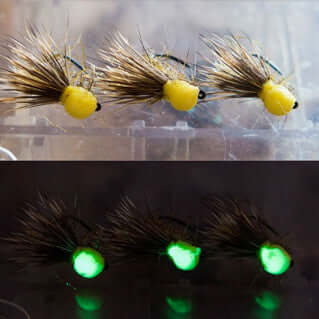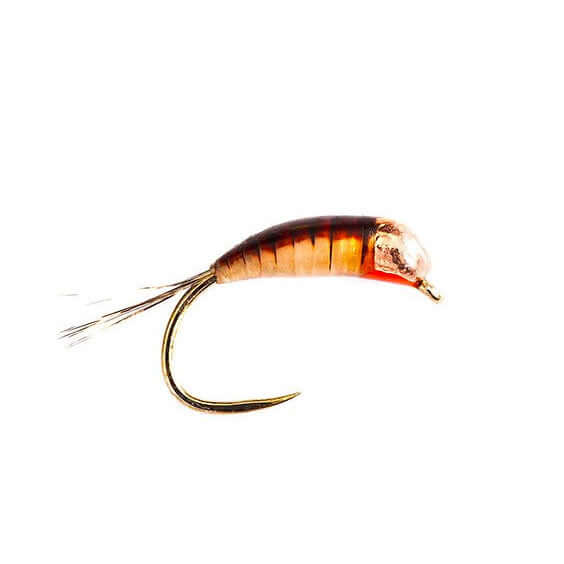A Matter of Choice
Trout anglers, I have noticed, have a tendency to fall into certain camps depending upon their age, background, values and so on. At one end of the scale we might have the traditionalist; a fisher of cane and silk perhaps, very much tuned in to the hatch calendar of the Ephemeroptera and preferring to cast the dry fly if at all possible. The polar opposite could be the modern day competition angler, utilising every available development in the sport to gain a cutting edge whilst competing on hard-fished waters against similarly determined opposition. For such a sportsman, little in fly fishing can be deemed out of bounds, so long as it conforms to the rules of competition.
What is acceptable?
As esoteric as our pursuit of trout is, most of us fall somewhere in the middle and I confess to finding the whole matter of what makes an individual tick - what they value and hold dear, and where they choose to draw the line of acceptability in their fishing - almost as fascinating as the sport itself. It's a question I have asked of myself more and more in recent years and as my own acceptance of more varied and innovative methods and flies has increased, so too has my understanding that not everyone gains pleasure from the same things - that so long as we operate within the rules and spirit of the sport and most importantly, with respect and care for our fish and the environment , then nothing can be gained by pontificating about what does and doesn't constitute true fly fishing. Certainly, there have never been greater technical developments in the catching of trout than those of the last decade or so.
The dark art of sunk flies.
I resisted some of the most recent ones for so long, part from ignorance and part fear of the unknown. Despite hailing from the north of England - a region traditionally more accepting of the darker arts of the sunk and weighted fly - I reached a point a few seasons ago where I felt that the techniques we had at our disposal were probably sufficient and unlikely to be improved upon significantly. As well as the traditional dry and wet fly and 'classic' upstream nymphing, the writings of contemporary competition scene exponents such as Oliver Edwards and Stuart Crofts had introduced to us such variations as Czech and Polish nymphing, duo, trio, and even river streamer fishing. An angler capable of deploying this full range of techniques when appropriate, would be an angler who could catch trout from any river in the country in nearly any prevailing conditions. I didn't feel that we needed any more - how could that arsenal be improved upon?
Modern fly fishing. What is it?
Well fast forward a few years and further advances have been made - the choice we now have is incredible. Add to the above list the 'leader only' French and Spanish methods, developments in super long and light rod building to suit the former, the increasing popularity of Japanese Tenkara, even boundary-pushing flyline technology, and I can see how the world of river trout fly fishing must seem baffling to a newcomer to the sport. About four years ago it had started to look baffling to me too and I resolved to do something about it. I shelved the 9' #5 rod which for so long had been accepted as a river standard, bought a 10' #3, built some stupidly long leaders and made a start teaching myself 'flyline-less' fishing....and a while later, after admittedly being sceptical bordering on dismissive, I tried Tenkara for the first time.

Typical UK wild trout country.
I can honestly say that I have never enjoyed my trout fishing as much as I do now. In the early days of my angling apprenticeship I approached day on the river by using the method I wanted to fish - the one I felt most comfortable with - regardless of whether or not that was the correct choice to bring success. As I gained experience I began to realise that if consistent catches were the target, then I would need to become proficient in several different techniques and learn to employ them at the right time; I worked hard at that and gradually developed into a steady but unspectacular angler who could have a stab at most disciplines and catch a few fish. Now the goal posts seem to have moved! An example: where once it was a matter of selecting to fish nymphs straight (off the line), or suspended (beneath a dry fly); today the choices are far more complex - OK so I can fish a pair of nymphs straight......but do I fish them 'classic' style, off a French Leader, using the Tenkara rod, or via one of the modern ultra thin lines? Sure enough, there is often some variable which puts one of the foregoing into pole position, but equally there are times when any of the above could be used equally effectively; and that is something I like very much. It has enhanced my angling enjoyment greatly, encouraging me to place less emphasis on the business of catching trout, and more on the execution of technique and those 'laugh out loud' moments a friend refers to when something which feels a bit crazy delivers an experience you know you will not forget in a long time. For me it's not so much about 'how many trout will I catch?' anymore, but 'what will be the most fun way to catch a trout today?'
Why not have a try at one of the following tactics? Each has put a huge smile on my face over recent seasons and not just because they are so effective, but because they have given my own angling a serious injection of the fun factor. There are many more variations to explore, but I can promise some interesting moments to anyone willing to give them a whirl.
The 'glow in the dark' dry fly.
Have you ever left the river in summer twilight with a heavy heart as all around, trout are on the feed and it has become too dark to effectively fish for them with the dry fly? Every season this happens to me on a handful of occasions as a late spinner fall or emergence of caddis sparks off a feeding frenzy all too late in the day and although reverting to a swung wet fly or skated dry might offer a few exciting and tactile moments in the gloaming, there is always this sense of an opportunity missed as I trudge back to the car. I couldn't see my dry fly once the light went altogether and that was effectively game over.

Glow in the dark dry fly
If this sounds familiar then try this: mix a dusting of fluorescent powder in with a lightweight flexible varnish and apply a drop to the upper surface of a suitably buoyant dry fly. Large footprint, low-riding patterns work best as they avoid being unbalanced by the relatively heavy varnish. Foam is an excellent base upon which to work and as such I find Roman Moser's balloon caddis ideal for the application - a small dab on the polycelon thorax cover works a treat. Leave to dry and then pop in the box to do its duty after the bats have come out. All you need now is one of those cheap UV laser pens (readily available online), and a quick blast from the torch will have the 'hotspot' glowing like a tiny beacon for a minute or two!
The first time I tried this (it's not my idea, a chap called Glen Pointon sowed the seed), I couldn't believe what I was seeing; or rather not seeing. One minute there was a green dot dancing downstream towards the sound of a slurping trout....... then it just disappeared. An almost disbelieving lift was met with the resistance of an angry and very surprised fish. I just stood there in the middle of the river laughing to myself! Since then I've used the method on a few late nights and revelled in the added dimension my summer fishing has gained. I've learned a lot more about the degree to which insects hatch and trout go on feeding after dark; once you get used to the eerie atmosphere much loved by sea trout anglers, the whole experience is magical and I recommend it without hesitation. Plus, how cool is it to say you've caught fish on the dry fly in total darkness!
Try an ultra thin nymph line.

Sunray World championship Nymph
A few leading manufacturers have started pushing the boundaries of what is possible with plastic coated fly lines. You might have seen the various 'competition nymph' tapers and reduced diameter lines on the market recently and maybe you dismissed them as a gimmick designed to part curious fisherfolk from their cash. There might be a grain of truth in that too: our sport is so fundamentally simple that it sometimes feels as if we reinvent the wheel just for the sake of it. However I have of late become fascinated by developments in the field of ultra thin fly lines and how far the 'fine and light' concept can be pushed before being defeated by basic physics. A line has to have sufficient mass to load a rod and therefore be cast right? Well yes, but with design of long and ultra light fly rods coming on apace, it feels like we are rapidly heading towards a place where our traditional western approach begins to bridge the gap to tenkara and other long reach reel-less disciplines . I recently fished with a prototype Sunray ten foot #2 rod which was so light and delicate that it cast a thin level taper nymph line as if it were a normal fly line, in much the same way as a tenkara rod casts a section of level fluorocarbon.
We are still a little way from such tools becoming mainstream though, but in the meantime any reasonably long and light river rod will handle one of the new generation nymph lines. It's great fun to fish our nymphs at a slightly greater range than modern European short style dictates - a return to the more traditional upstream nymphing of old where the floating line is laid on the surface and the tip watched for indications of a take.....except such is the lightness and sensitivity of these lines that trouty interest registers as a most decisive jab forward, even to the point where the take is occasionally felt under the rod hand at the same time as the visual indication. It's great fun, particularly when fishing pocket water for actively feeding summer trout.
French leader in summer pool heads.
Amongst the younger generation of fly fishers, the French leader in its various guises and tapers is almost ubiquitous nowadays, and it's not surprising given how effective a method it is for tackling sub surface feeding fish. However like many who fell in love with its charms, I ended up overusing it for a while and tended to fish little else when nymphs were called for, even for the 'right under the rod tip' business of short lining in heavy water. You see that quite a lot now - anglers fishing at very short range with a French Leader and although it is undoubtedly effective in that role, you could argue that the real benefit is lost and reverting to a straightforward level leader would achieve much the same.
The last two dry summers have lent themselves to fishing the French leader in a way more akin to its original intention, that is to present small nymphs at range, to nervous fish lying in very shallow water. On the fairly large spate rivers I fish, that usually means the brisk skinny water at the very heads of the pools and I had a few real eye openers last summer when using this method to connect with surprisingly large trout which were occupying water barely deep enough to cover their backs. I wasn't surprised that they were there - such water offers reasonable oxygenation in times of drought, and is the environment from which so many of the Baetis olive species emerge right through the season - but I was still surprised to catch them so regularly. The reason of course, was very likely the greater range and stealth afforded by the French leader and I kicked myself for not having played to its strengths earlier. To cast a tiny weighted nymph into inches of fast water and suddenly find yourself attached to a couple of pounds of angry wild trout is surely one of the most exciting experiences river fishing in this country has to offer.
Downstream dry fly on the Tenkara rod.
Tenkara is slowly but surely winning over more and more anglers - still a divisive method (usually denigrated by folk who have yet to try it), but having been at least partially converted myself, I defy anyone to have a go and not admit tenkara is at the very least an absolute hoot! Aside from using it as a medium to deliver conventional UK tactics (and not yet having delved into the more true to origin style of fishing wet kebari flies), the most illuminating experience I have had so far with Tenkara rod in hand is that of drifting dry flies downstream to visibly feeding fish. For anyone who hasn't tried this, I urge you to have a go as it is a real experience: the reach and delicacy of the set-up means that with care a rising trout can be approached from upstream and the fly more or less plonked on its nose. In fact the fly can be dropped exactly in the right place, without any worry about intervening drag. If a greater lead is required, stopping the rod high on the delivery introduces enough slack to allow it a few feet of downstream drift as the rod tip is lowered.

A fine UK wild trout on light gear.
Most importantly, because very little line is in contact with the surface (we are almost dapping really), the fly can be lifted off and re-cast a number of times without the fish showing the slightest concern. I recently tried this with a new rod of fifteen feet in length. Coupled with the same length leader and about 5 feet of tippet the reach was absolutely phenomenal and I was able to repeatedly cover fish way off downstream, sometimes rising and missing them before hooking up a few casts later. As a means to fool trout occupying tricky lies on the very tails of pools, I cannot think of better.
Evolution or Witchcraft?
So there you have but a handful of the wealth of options now available to the open minded river anger; but by way of conclusion, it might be worth sounding a note of caution. We could enter into a debate over the boundaries of fly fishing here. The traditionalist will not likely be particularly interested in the subject of this essay and may even question the ethics of some of these super effective means of fooling trout. I can relate to this viewpoint and plenty times I have mused over how much more efficient we anglers would need to become before we could catch any fish in residence and all the mystery of our rivers were lost. Well that might be a bit far-fetched, but I do believe that whilst our ever expanding range of techniques might facilitate better catches and therefore greater enjoyment we do need to be mindful that there also exists the potential to pressure our precious stocks of native wild brown trout to a greater degree than ever before.
A wise old friend of mine has made this point on more than one occasion when I have suggested that the number of trout and grayling we catch on our local rivers indicates that stocks remain in good health. "Ah but modern anglers are so much more proficient at catching than we were when restricted by primitive tackle and methods", is Terry's response. Food for thought there for certain, and I do believe that as ever, we have a duty to exercise the greatest respect for our quarry......the emphasis required to educate anglers in catch and release best practice has arguably never been greater. But when all's said and done, so long as we continue to care for our trout and aquatic environment, and fish responsibly within the rules imposed upon us, then I honestly believe that there has never been a better time to enjoy fly fishing - the fun factor is definitely there if you are prepared to embrace the change!
































